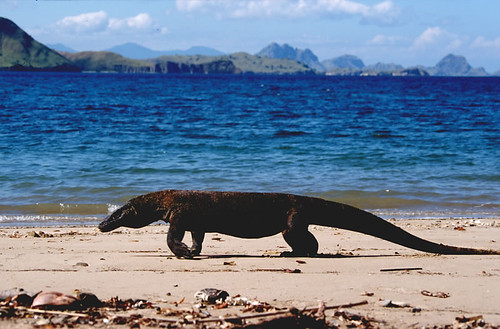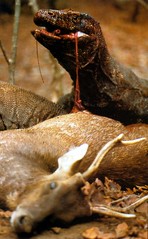Scientists To Sequester T-Rex Tissue On Komodo Island

Aside from the usual, solitary scientific doldrums,
scientists will be able to break from the monotonous
task of sequestering T. Rex soft tissue to study the
affable Varanus Komodoensis
Indonesia--Scientists who have isolated a "flexible, filament material" from the bone of a Montana T. Rex excavation are taking no chances whatsoever, when it comes to genetic temptations.
"Because we live in a time when the overwhelming desire to tamper with forces beyond our clinical control is so strong, we will enact intractable safeguards at the outset" said Dr. Mary Schweitzer of North Carolina Sate University.
Schweitzer says that, while simple clinical isolation would be "acceptable protocol," it falls short in terms of societal proximity.
“We are making arrangements even now, for the erection of a laboratory somewhere in the Indonesian Islands,” she said. “Komodo Island seems to be the most conciliatory in terms of climate, coastal access, plus a preponderance of frogs with androgynous DNA.”

Schweitzer says they are excited to
finally unravel "what makes these
lizards tick" while isolating bloody
T. Rex cartilage
Scientists also agree that a proliferate supply of “understudied” lizards with 61 noxious salivary toxins provides a nice peripheral justification for the move.
"They grow to nine feet long, 200 pounds, live twenty years and can run 20 miles an hour," said one scientist. "They are solitary creatures, good swimmers, and have the eyesight of an eagle. We'd like to get into the psyche of the only living prehistoric carnivore while we have he chance."
Schweitzer says that "nay sayers" are attempted to circumvent their plans by citing the ability of the indigeounous creatures to ambush unwitting victims, subject them to fatal infection with one bite, and track an injured specimen for miles.
"It will only be us scientists, and my two grand children," she said.
NCSU scientists said that, while the theoretical premise for this move is simple, that budgetary issues are extraordinary.
“First there is the laboratory itself,” said one assistant to Schweitzer. “After that you have the brightly painted SUV’s with coordinating logos, the 30 foot security fences, and the closed circuit monitoring.”
Schweitzer also says that eventual tours of the park are foreseeable.
“We have already booked an exclusive tour of the island,” she said. “With a leading paleontologist, his paleobotanist love interest, and a wise-cracking mathematician who makes uncouth remarks about the size and scope of dung, although we were interested in him because of his magnum opus on chaos theory.”
Schweitzer says, “no expense will be spared” to assure genetic responsibility.




<< Home